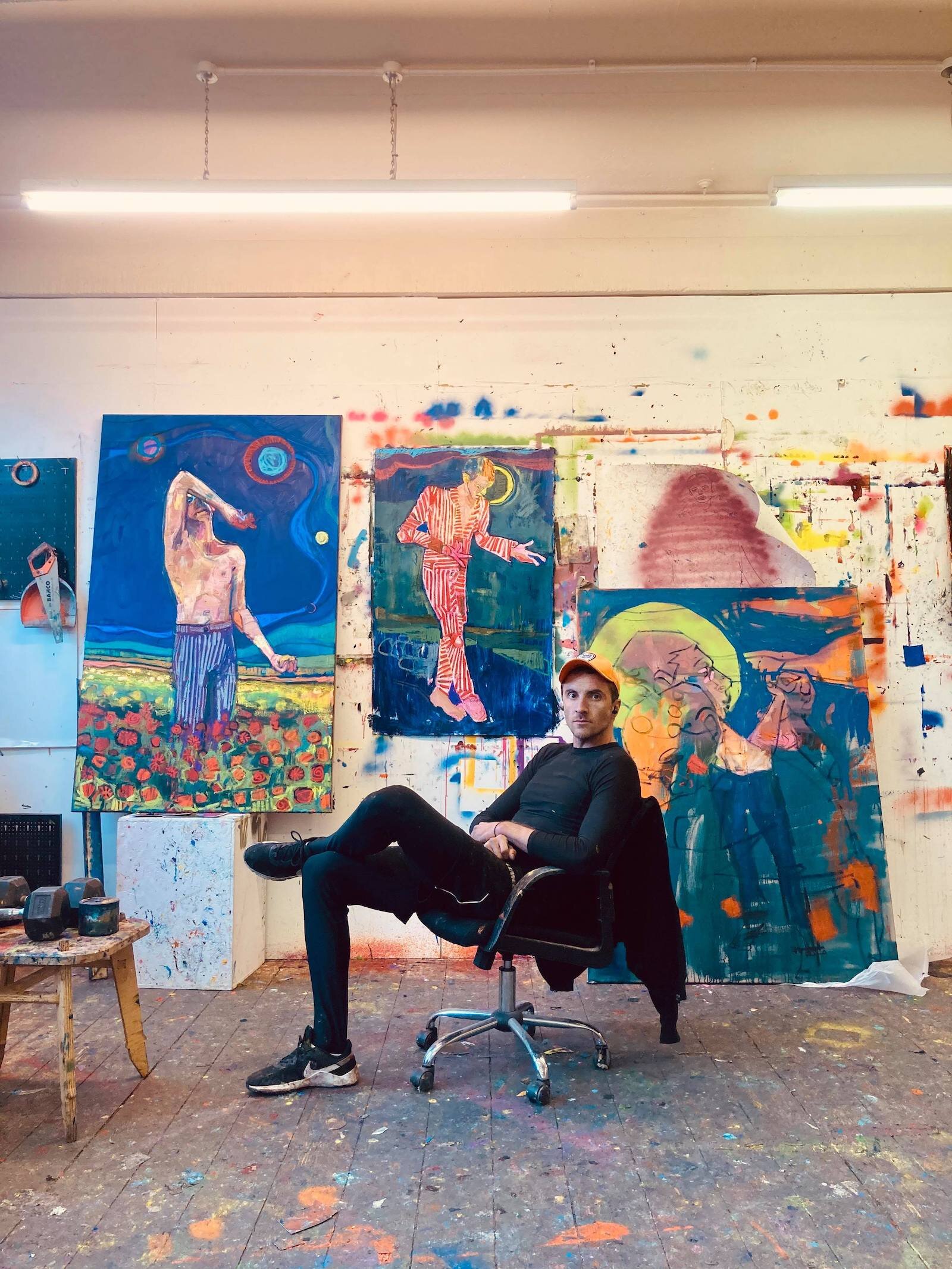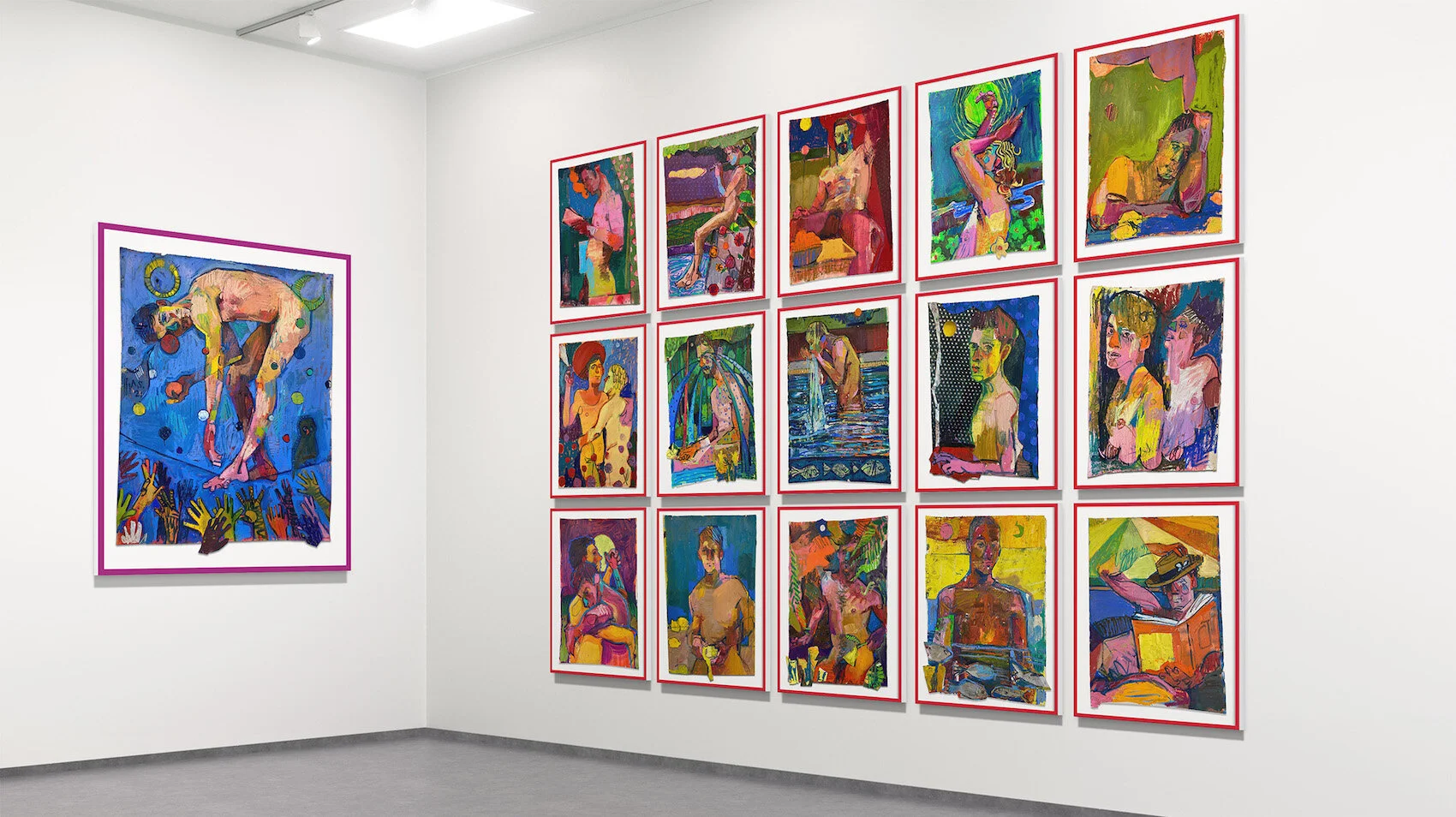Andrew Salgado is an artist I have been following from early on in his career, I personally look at his work as tableaux, simply because of the detail and content of each piece. As an artist, I have taken inspiration from his paintings in many parts of my practice, so I was really excited as Andrew is very busy, that he agreed to do this Q&A for our Queer Art Issue…
Bio…
ANDREW SALGADO (b. 1982, Canada) graduated with an MA in Fine Art from Chelsea College of Art in 2009 and is regarded as one of the United Kingdom’s leading figurative painters. Since 2010, he has had 15 sold-out international solo exhibitions in London, New York, Cape Town, Basel (Switzerland), Zagreb (Croatia), Toronto (Canada), and Miami.
In 2017, Salgado was the youngest artist to receive a survey exhibition at The Canadian High Commission in London. He has received press both online and in print, including GQ, The Evening Standard, The Independent, Artsy, METRO, Attitude Magazine, Globe and Mail (CAN), and Macleans (CAN). He frequently donates to charities including Pride London, Stonewall, Diversity Role Models, Pride London, and GLAAD. His donations to the Terrence Higgins Trust are of particular note, having have raised over £100,000 since 2014. In March 2019, he entered the secondary market with a piece in a Strauss & Co auction in South Africa that doubled its estimate.
His works have been collected extensively in private and public collections worldwide, including the Government of Canada, The Jordanian Royal Family, Simmons & Simmons, and the Esquinazi Collection.
1. How did you come to be an artist, at what age, and at what point did you decide on abstract figurative painting?
I was always artistically inclined. My mother tells stories about how I didn't want colouring books; I preferred blank paper. I remember being young and drawing for hours and hours. I think I was a bit insular, really, as a kid. I think I'm still a bit insular, as an adult, you know? I crave this alone time. I think a lot of creatives have that desire, that obsesses, for alone time, because that's where the energy comes from.
Like most emerging artists I flirted with various styles. It wasn't until about 2008 that I really hunkered down and made a career out of it... I was about 25, 26. Figurative just felt like it had emotional resonance, and meaning. Identity is this keyword that we hear a lot. I'm not sure that's enough anymore, to just explore identity, but at the time, that's what was important to me. That's what I did.
2. Traditionally the male gaze has prominently produced paintings relating to the female image, with not much background narrative. I know your work is based around politics and narrative and you do paint women, but much of your paintings are of men, as a gay artist and LGBTQ activist do you think this is important and why?
Am I an activist? That's a heavy term to live up to. I believe in being vocal; sometimes I fear if I'm labeled an activist it comes with the pressure to always be political and progressive and sometimes I just want to be quiet, self-indulgent. I used to say 'if your paintings aren't political stop wasting my time because at the time I was still very actively campaigning for LGBT equality and my own personal issues. That's a heavy cross to bear. I no longer believe that. Sometimes I just want to be able to paint a pretty still life with some oranges and flowers and not have to have a manifesto behind it, haha. Of course, the relevance is there. The greater conceptual movement and they do tend to be very LGBT-focused, and I continue to be active with charities and such, but perhaps the work is becoming both more intimate and more externalized. I worked myself into a very dark place after 2016 with my show The Snake, and it affected me mentally. Psychologically. I just wanted to be able to work from a place of peace and happiness. There is a lot of anger in activism because injustice means you have to get angry to make a stand. And I just wanted to be... not angry. There's that famous Bjork line where she sings 'it takes courage to enjoy it, and I don't think that being at peace, and being quiet is necessarily a bad thing. I have a platform, I use it. But I use it more sparingly these days.
3. I have seen your work up close and love the way the energy and colour draw you into the story, but I feel they also have this wonderful bitter/sweet relationship with the subject, viewer, and material. How do you decide on a subject, is it idea/ theme first or object /person? Also, do you plan a painting before you start?
There is no magic formula, really. I take notes, mental notes, or actual physically I will jot something down. I rarely sketch. I'm trying to sketch more. I just bought a sketchpad and pencils. Sad, isn't it? I should really romanticise this idea that I'm always scribbling some wonderful potential masterpiece! hah! In truth I read a lot; I find inspiration from books, music, memories. I met Tori Amos once and she told me to cleanse my palette; it's true. I was 19. She had no idea I was a painter, but she said 'cleanse your palette and then collect things, be they physical or metaphysical, and let them ruminate'. She has a very particular way of phrasing things, and I never forgot what she said. So I do that. I collect things. Simple things that are laden with meaning - for me. And maybe of total insignificance to someone else. So things sort of bounce back and forth - you know? This idea of a sunflower. And then this idea of a cramped figure, after my leg went asleep while I was reading on the sofa with my partner; a photograph of a boy in his underwear. And then I read Derek Jarman's 'Modern Nature', and what he wrote about chrysanthemums. And yeah, click click click, these things suddenly fall into the pot and maybe make some magical brew. So yeah. that will be a painting. And this is an LGBT zine? yes? Yes, read Modern Nature.
4. How do you edit your work? Is there a process if something just isn’t coming together?
Yes, just yesterday I chucked two paintings. But beauty comes from detritus. It's important to self-edit. It's important to have standards. It's like an itch, isn't it? It should be a challenge, but it should be effortless. The ones that aren't working feel overly burdened from the get-go.
5. As narration is important for your paintings, I am intrigued to know is the person who is the subject related in any way to the narrative within the painting, or are they just a character?
Oh gosh. I don't even know. It depends, doesn't it? It depends on the painting. And I suppose your relationship with that character can be very different from my relationship with that character. I think the person in the painting always has secrets - there has to be an element of mystery or something that’s just off, just marginally not right. So that you return to it. There was this David Usher song called 'Disco Days' from like, a million years ago. He sings one note in the wrong key. It sticks with you. It stuck with me. I don't want to answer questions about the paintings, I want to pose the questions and then walk away. Open a door and then step out of the light so you can take your own journey. Gosh, that sounds so profound. I'm hungover so I tend to be all 'metaphoric' haha
6. As a Canadian artist, what made you settle in London?
I came in 2008 to do my Masters at Chelsea College of Art. Peter Doig went there so I thought, ok I'll go to Chelsea and become a famous artist. It's more complicated than that.
7. If you could go back 10- years What would you tell your younger self?
Chill the fuck out, dude.
8. As you know this issue is about promoting queer art and artists. As an LGBTQ activist and artist, with the influx of digital arts and the lack of representation higher up the ladder of the art so to speak, what advice do you have for up-and-coming LGBTQ… art students who might be questioning painting and the arts in general as a career path?
I mean... is there less representation in the higher-ups? The art world has always been quite gay. Or at least gay-friendly. Perhaps this is a generational thing too. Like, these chemtrails and 5G towers aren't turning your kids gay, Karen, they're just more comfortable identifying with the LGBT spectrum. We are less repressed. I mean when I started painting 10-15 years ago I was told to tone it down. The worst advice I ever got. Jonathan Lyndon Chase has made a career out of painting puckered anuses, FFS.
What's my advice? Um.... the art industry is as fickle and catty as the gay community can be. So protect yourself. I sound nihilistic, I suppose. But I can't pretend either path is laced with roses. Work hard. Stick to your guns. Find a path that operates outside of anyone's trend...it's how I've lasted. It's how I hope to last. Be grassroots. Do it yourself. It's what I did. It's what I still do. It's always an uphill battle, gosh I just realized how hand in hand being gay and being a painter is. I just had an epiphany, I think. But really, haha, there's a lot of struggle. But it’s worth it. Oh god, the highs are so so fucking high but sadly, with that come the lows.
9. Finally in your opinion how would you define queer art, as this construct is constantly in flux? Do you think anything needs to change and if so in what areas, if not why not?
How would I define queer art? How would I define queerness? I don't know. Fuck definitions, right? That's what has been used to categorize, and to categorize is to entrap, encase, seal. We don't want that. Fuck definitions. Be whatever you want. Do whatever you want.
Andrew Salgado’s future projects and exhibitions
The forthcoming exhibition is in November in NYC…
There is a reissue of monograph TEN in 2022, and a new monograph (covering 2017-2021) entitled Tomorrow I'll Be Perfect.
Website: - Andrew Salgado
Andrew is represented by Beers Gallery London





